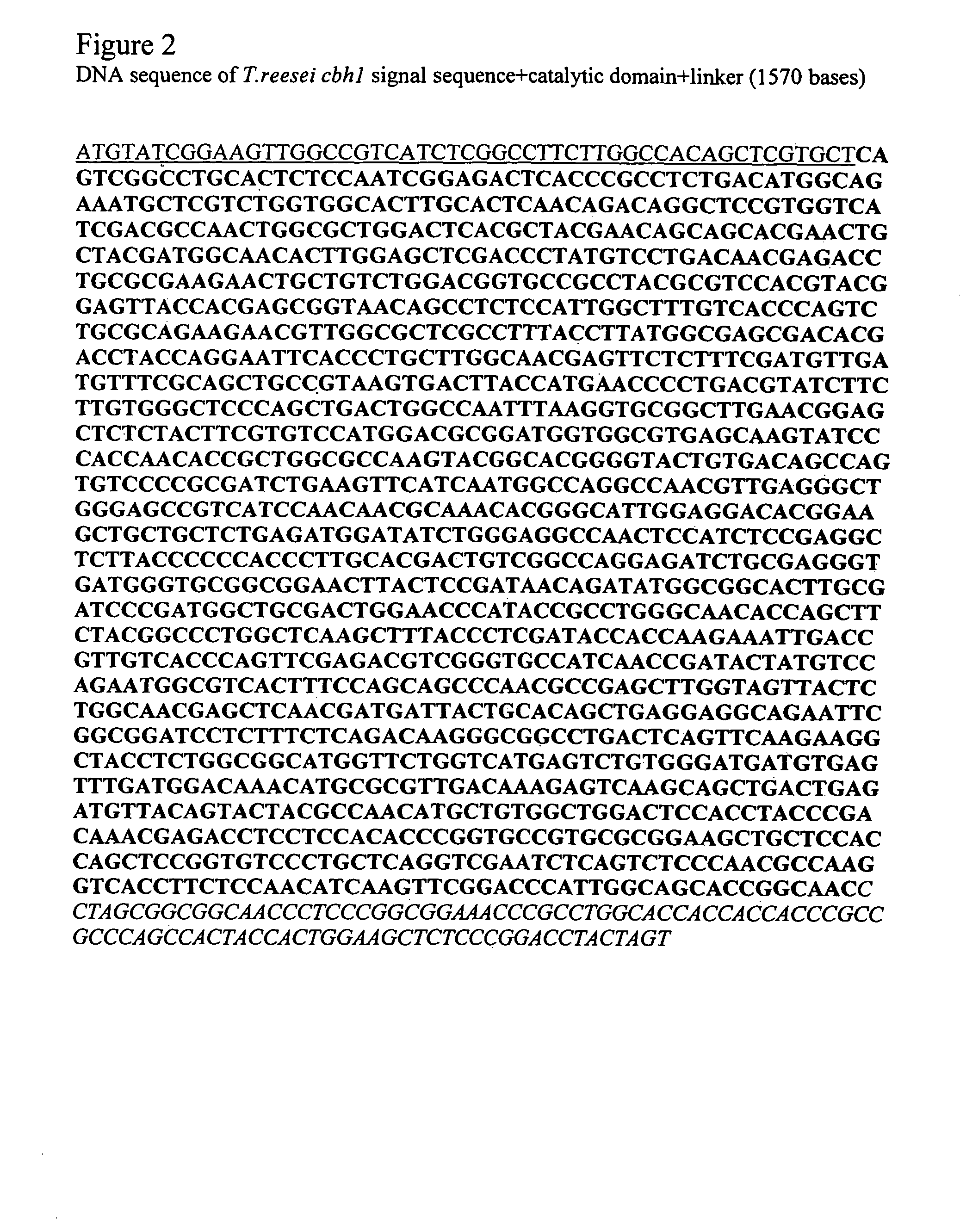Exo-endo cellulase fusion protein
a cellulase and exoendo cellulase technology, applied in the field of heterologous exoendo cellulase fusion constructs, can solve the problem of low yield of filamentous fungi's bacterial enzymes
- Summary
- Abstract
- Description
- Claims
- Application Information
AI Technical Summary
Benefits of technology
Problems solved by technology
Method used
Image
Examples
example 1
Construction of a CBH1-E1 Fusion Vector
[0165]The CBH 1-E1 fusion construct included the T. reesei cbh1 promoter; the T. reesei cbh1 gene sequence from the start codon to the end of the cbh1 linker and an additional 12 bases of DNA 5′ to the start of the endoglucanase coding sequence, a stop codon and the T. reesei cbh1 terminator (see FIGS. 10 and 11). The additional 12 DNA bases (ACTAGTAAGCGG)) (SEQ ID NO. 16) code for the restriction endonuclease SpeI and the amino acids Ser, Lys, and Arg.
[0166]The plasmid E1-pUC19 which contained the open reading frame for the E1 gene locus was used as the DNA template in a PCR reaction. (Equivalent plasmids are described in U.S. Pat. No. 5,536,655, which describes cloning the E1 gene from the actinomycete Acidothermus cellulolyticus ATCC 43068, Mohagheghi A. et al., 1986).
[0167]Standard procedures for working with plasmid DNA and amplification of DNA using the polymerase chain reaction (PCR) are found in Sambrook, et al., 2001.
[0168]The followin...
example 2
Transformation and Expression the CBH1-E1 Fusion Construct into a T. reesei Host Strain
[0174]Various T. reesei strains were transformed with the CBH1-E1 fusion construct. The host strains included a derivative of T. reesei RL-P37 and a derivative of T. reesei wherein the native cellulase genes (cbh1, cbh2, egl1 and egl2) were deleted.
[0175]Approximately one-half swab (or 1-2 cm2) of a plate of a sporulated T. reesei derivative of strain RL-P37 (Sheir-Neiss, et al., 1984) mycelia (grown on a PDA plate for 7 days at 28° C.) was inoculated into 50 ml of YEG (5 g / L yeast extract plus 20 g / L glucose) broth in a 250 ml, 4-baffled shake flask and incubated at 30° C. for 16-20 hours at 200 rpm. The mycelia was recovered by transferring the liquid volume into 50 ml conical tubes and spinning at 2500 rpm for 10 minutes. The supernatant was aspirated off. The mycelial pellet was transferred into a 250 ml, CA Corning bottle containing 40 ml of B glucanase solution and incubated at 30° C., 200 r...
example 3
Assay of Cellulolytic Activity from Transformed Trichoderma reesei Clones
[0191]The following assays and substrates were used to determine the cellulolytic activity of the CBHL1-E1 fusion protein.
[0192]Pretreated corn stover (PCS)—Corn stover was pretreated with 2% w / w H2SO4 as described in Schell, D. et al., J. Appl. Biochem. Biotechnol. 105:69-86 (2003) and followed by multiple washes with deionized water to obtain a pH of 4.5. Sodium acetate was added to make a final concentration of 50 mM and this was titrated to pH 5.0.
Measurement of Total Protein—Protein concentration was measured using the bicinchoninic acid method with bovine serum albumin as a standard. (Smith P. K. et al., Biochem 150:76-85, 1985).
Cellulose conversion (Soluble sugar determinations) was evaluated by HPLC according to the methods described in Baker et al., Appl. Biochem. Biotechnol. 70-72:395-403 (1998).
[0193]A standard cellulosic conversion assay was used in the experiments. In this assay enzyme and buffered...
PUM
| Property | Measurement | Unit |
|---|---|---|
| weight percent | aaaaa | aaaaa |
| weight percent | aaaaa | aaaaa |
| pH | aaaaa | aaaaa |
Abstract
Description
Claims
Application Information
 Login to View More
Login to View More - R&D
- Intellectual Property
- Life Sciences
- Materials
- Tech Scout
- Unparalleled Data Quality
- Higher Quality Content
- 60% Fewer Hallucinations
Browse by: Latest US Patents, China's latest patents, Technical Efficacy Thesaurus, Application Domain, Technology Topic, Popular Technical Reports.
© 2025 PatSnap. All rights reserved.Legal|Privacy policy|Modern Slavery Act Transparency Statement|Sitemap|About US| Contact US: help@patsnap.com



